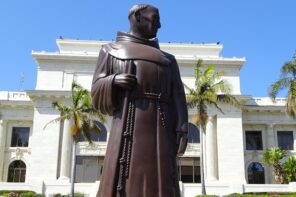A very strange story was reported on the AP wire recently: They’ve discovered the head of Nicolaus Copernicus (1473-1543), and re-interred it with pomp and ceremony in the Cathedral of Frombork.
The symbolics of this story are worth considering: this is the skull that once housed the brain of the man who first imagined the heliocentric theory that the earth was not the center of the universe, and thereby theoretically displaced our world and humanity as the very apple in God’s all-seeing eye.
So, how had his head come to be lost? Not the way you’d think.
It seems that Copernicus’s revolutionary theory was not as controversial when it was first reported to the Vatican as it later became. The reason for that had little to do with science, directly, and a lot to do with the Protestant Reformation. The Lutheran heresy had made the Vatican a little skittish about free-thinking creative individuals turning their speculative attention to ground presumably already covered by divine scripture.
So Copernicus’s ideas were deemed heretical later on, at the height of the Counter-Reformation.
These days, the Vatican is trying to put a positive face on such medieval-seeming heresy hunts. The contemporary Catholic church is unapologetically modern when it comes to astronomy and physics. And so in 2004, a local bishop in Frombork, Poland, invited scientists—yes, scientists—to undertake an archaeological examination of the local cathedral, in order to identify the bones of Copernicus.
It seems that Copernicus was anything but a household name when he died; he was simply a canon working in this same church, one who tangled periodically with local officials, not over science, but over morality. It also seems that Copernicus kept a mistress for many years, violating his celibacy vows, and eventually was forced to end the relationship.
When Copernicus died, his remains were installed in an unmarked grave in the floor of the Cathedral, which was a fairly common practice for a man of his rank (he served the church at a clerical rank just shy of the priesthood).
The archaeologists found a skull and some other skeletal remains in 2005. Initial study confirmed them to be the remains of a roughly 70-year-old man, and evidence of a broken nose fit what we know of the historical Copernicus.
Then, in a surreal version of “CSI Frombork,” DNA analysis performed on samples taken from the teeth and bones matched a DNA sample taken from hair found in one of Copernicus’s books.
And so with great pomp and circumstance, Copernicus’s remains were re-coffined, taken on tour around the region near Frombork, and then laid in state in the selfsame Cathedral, but now marked with a black granite stone identifying Copernicus as a national hero, and founder of the new astronomy. His tombstone is decorated with a golden sun, encircled by the six planets he would have been able to see with the naked eye.
In 1992, you may recall, Galileo was also rehabilitated by the Vatican. The Church’s desire to show itself pro-modern in scientific matters is very clear. But both the previous Pope, who was also a Pole, and this current Pope have both shown themselves to be profoundly pre-modern, if not actually anti-modern, in ethical matters, working tirelessly against the Second Vatican Council’s accommodation to the modern world.
So the bones of this old Catholic cleric are being put to some complicated modern purposes. It’s partly about the Catholic accommodation of the new science, a rapprochement insisting that there is no necessary conflict between science and religion. But it’s also partly a matter of national pride, in a long-suffering country desperately in need of something to celebrate. There is surely also an economic profit motive, since this will surely make the Frombork Cathedral a prominent tourist destination.
The story also seems like it’s been taken from one of the more surreal moments in Hamlet: “Alas poor Yorick, I knew him well, Horatio.” Of course, what we in the audience know is that this half-mad Prince who’s just leapt into an open grave doesn’t know anything; he’s making the skull’s story up as he goes. As Sartre knew all too well, “the dead are prey to the living.”
We do not know Copernicus well. He died precisely when his masterwork, “On the Revolutions of the Heavenly Spheres,” was published, and so he did not live to tell us what it meant to him, nor how he might have felt about the later claims of heresy attached to, and detached from, his theories.
The man is being reassembled quite literally from fragments—a common enough practice in contemporary archaeology—to tell a strange story that modern scientists and this Papacy both apparently wish to tell.




